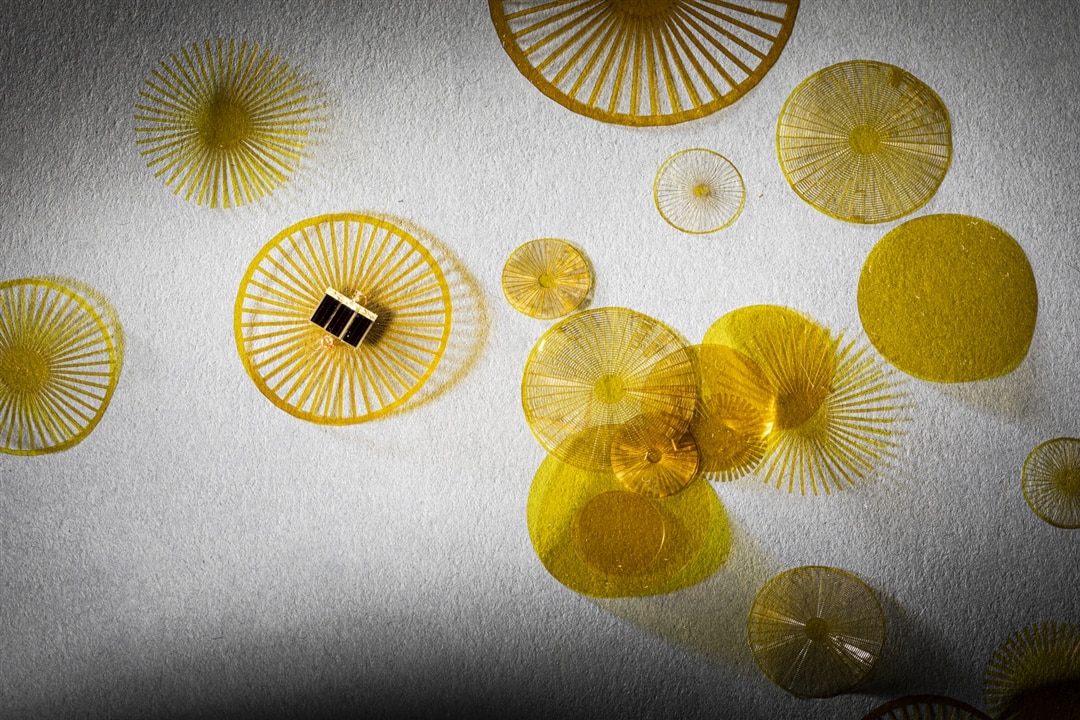
The image shows solar panels that supply power to the electronics. (Image Credit: Mark Stone/University of Washington)
University of Washington researchers recently built a sensor-carrying device that rides the wind to travel while falling. Overall, the system, which can move up to 100 meters on a moderate breeze after being released from a drone, is 30 times heavier than a 1-milligram dandelion seed. The device features solar panels that provide power to each component and transmits data up to 60 meters away. These could become applicable for monitoring climate change, digital agriculture, etc.
“We show that you can use off-the-shelf components to create tiny things. Our prototype suggests that you could use a drone to release thousands of these devices in a single drop. They’ll all be carried by the wind a little differently, and basically, you can create a 1,000-device network with this one drop,” said senior author Shyam Gollakota, a UW professor in the Paul G. Allen School of Computer Science & Engineering. “This is amazing and transformational for the field of deploying sensors because right now, it could take months to manually deploy this many sensors.”
Making the system as lightweight as an actual dandelion seed has proven challenging due to the integrated electronics. First, the researchers made the system into a specific shape so that it could drop seamlessly to the ground while allowing the breeze to move it around. The team performed experiments with 75 designs to figure out the device’s smallest terminal velocity or maximum speed as the system dropped through the air.

Overall, the team tested 75 designs for their prototype device to determine the maximum speed. (Image Credit: Mark Stone/University of Washington)
“The way dandelion seed structures work is that they have a central point and these little bristles sticking out to slow down their fall. We took a 2D projection of that to create the base design for our structures,” said lead author Vikram Iyer, a UW assistant professor in the Allen School. “As we added weight, our bristles started to bend inwards. We added a ring structure to make it more stiff and take up more area to help slow it down.”
The team had to integrate solar panels on the system rather than a battery to maintain its lightweight quality. The solar panels face upright 95% of the time after landing on the ground. It also falls and flips over in an upright orientation, imitating a dandelion seed. On the downside, the system cannot store energy without a battery. So the sensors no longer operate during nightfall. However, the system needs some energy to start working again in the morning. Thus, the team added a capacitor to store a charge overnight.

The device contains sensors, a capacitor, and a microcontroller on a flexible circuit. (Image Credit: Mark Stone/University of Washington)
These devices’ sensors, which measure temperature, humidity, pressure, and light, transmit data back to the researchers through a backscattering approach. This process occurs throughout the day, stopping at sunset when the device becomes inoperable and continuing when the devices turn on in the morning. The team dropped each system from varying heights via drone or hand to determine how far they travel by wind. An efficient trick toward dropping each device from different points involves minimally altering their shapes, causing the breeze to carry them differently.
Since the system is battery-free, each component receives an unlimited energy supply, so it can run until it breaks down. However, this also means that the electronics will be scattered across an ecosystem of interest. So the researchers are exploring ways to produce more biodegradable systems.
Have a story tip? Message me at: http://twitter.com/Cabe_Atwell
